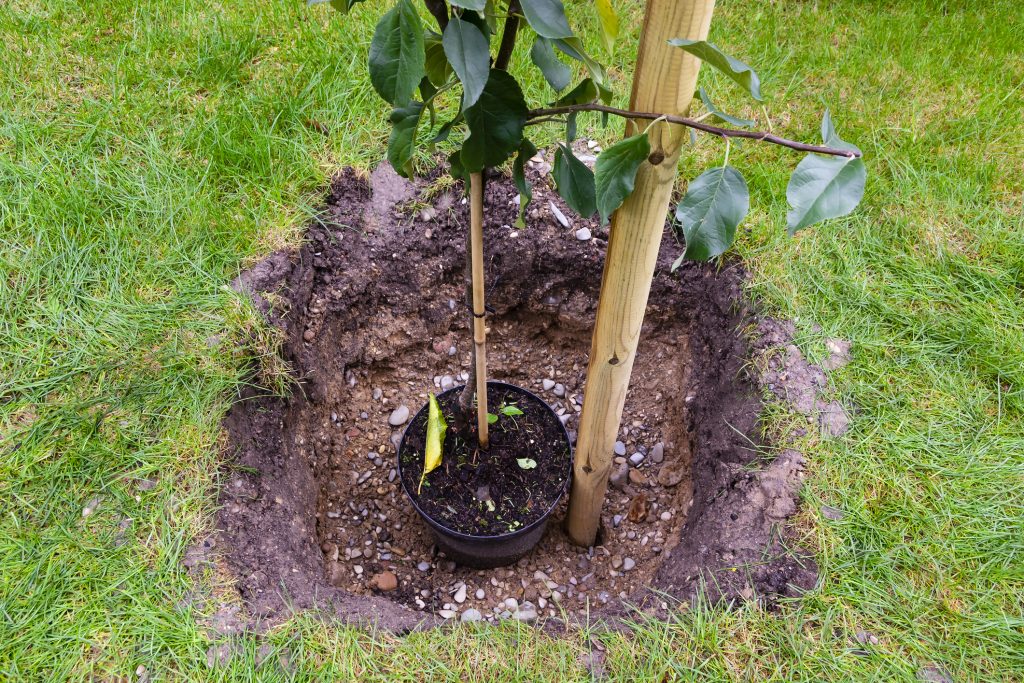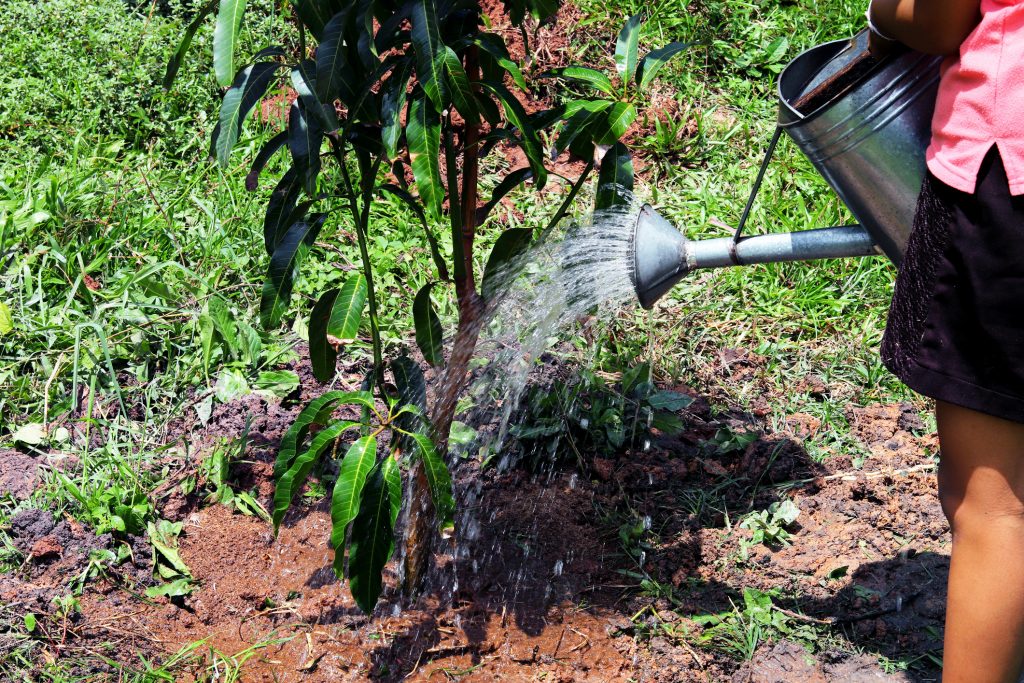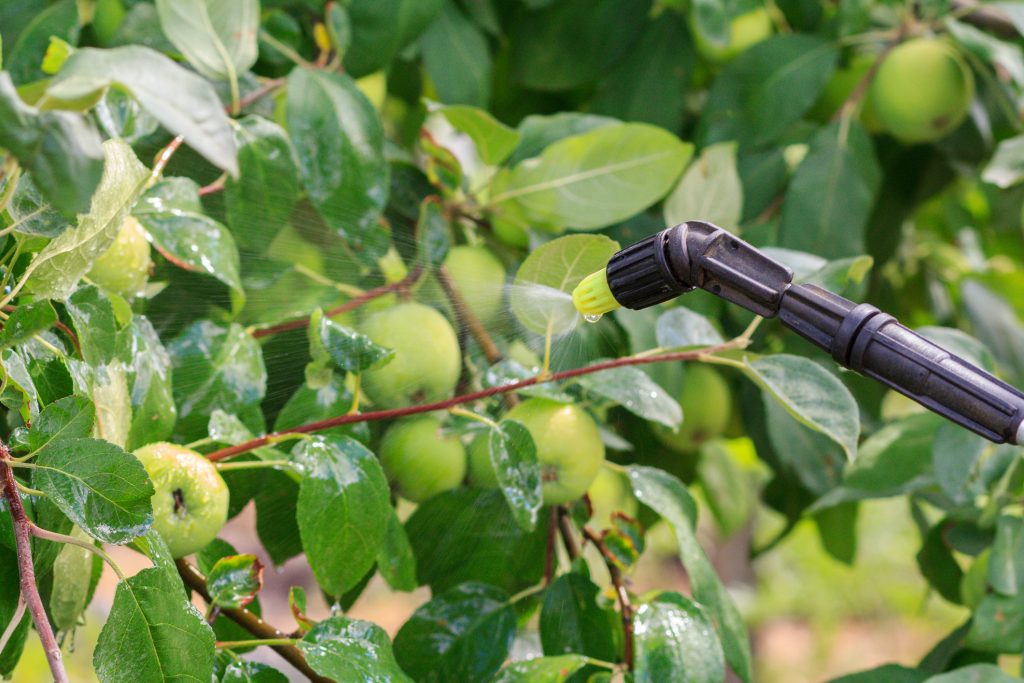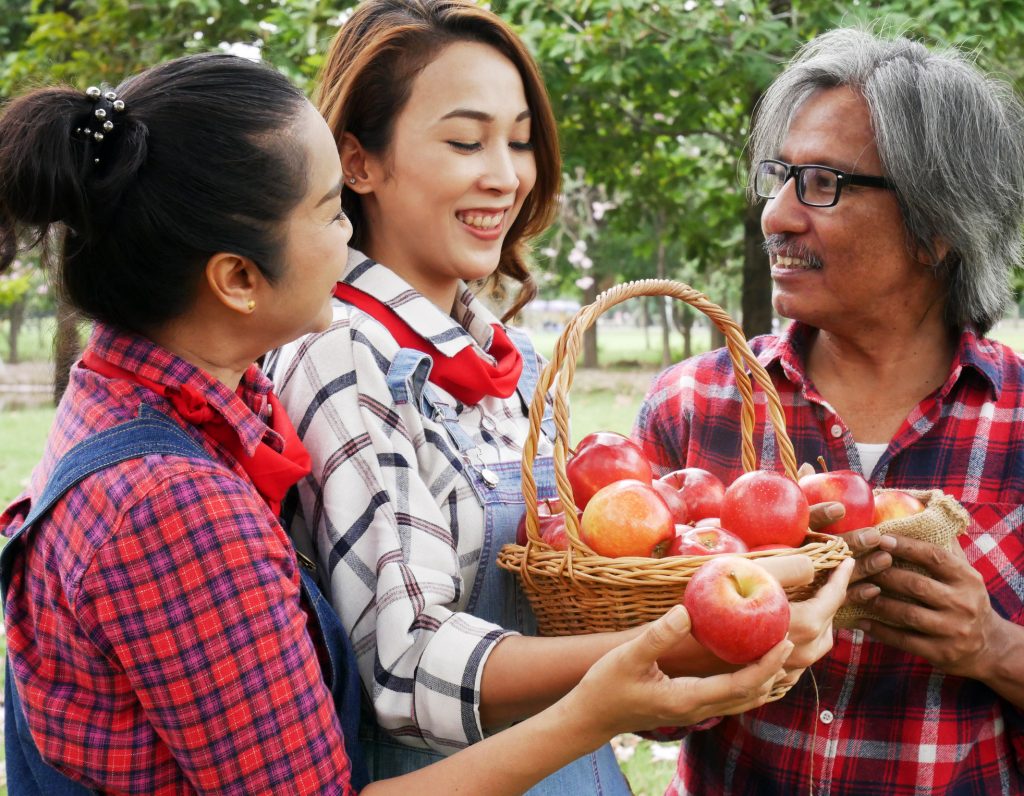
Updated: March 7, 2025
A home orchard is a valuable investment, but without proper care, it can be disappointing and unproductive. Our long experience has proven that success can be assured if good management practices are followed. The information provided in this guide can be applied to most fruit trees. Planting, training, pruning, fertilizing, and spraying are about the same for apples, pears, plums, and peaches. Exceptions are noted.
Our fruit trees are held in a special cold storage environment to maintain dormant, live, high-quality trees. Proper care of trees before planting, attention to detail in planting, timely applications of water, and proper pruning will help ensure success and the reward of good crops of fruit for many years.
7 Tips For Planting Young Fruit Trees

Choosing A Location For Your Fruit Trees
Unfortunately, most home orchardists have little choice of location or soil where trees can be planted. Fruit trees do best in fertile, moist, well-drained soil, and they all require full sun. Avoid low spots where water stands for a day or two after a good rain.
How To Dig A Hole For Your Fruit Trees
When planting fruit trees, make sure the hole is large enough to fit all roots without bending. Trim any extremely long roots so the remaining roots can be spread out evenly. Refill the hole with topsoil or a mixture of soil, peat moss, and compost or rotted manure.
Which Inoculant & Fertilizer Should I Use On My Young Fruit Fruit?
All newly planted fruit trees will benefit from the addition of MYKE Tree & Shrub Inoculant, which is a natural mycorrhizal amendment. You may also opt for adding a slow-release fertilizer such as Gromax tablets.
How Deep Should I Plant My Fruit Tree?
Plant fruit trees so that the root closest to the surface is covered with at least 1 to 2 inches of soil. The graft union must be above ground level and its height above the soil surface may vary from 2 to 18 inches.

How Far Apart Should I Plant My Fruit Trees?
Pack the soil firmly around the roots and water thoroughly. Space fruit trees on dwarf rootstock 10 feet apart, those on semi-dwarf rootstock 12 to 15 feet apart, and standard trees no closer than 30 feet apart.
Staking Your Fruit Trees
Staking young trees to provide stability while they become established is helpful for all trees, but it is required for dwarf rootstock trees.
Pruning Your New Fruit Tree
After a tree has been planted it must be tip pruned. Pruning will help shape the tree and reduce moisture stress caused by the loss of fine roots in digging and transplanting. Most importantly, tip pruning stimulates the hormonal actions of the tree to grow more roots and to start the process of producing axillary buds and shoots. Tip pruning also brings the top size of the tree into balance with the number of roots it has to supply the emerging shoots with water and nutrients. If the top size is not reduced, new shoots will appear and then quickly die off and the tree will then decline and possibly die.
If your tree is an unbranched whip, cut it back ⅓ to ½ of its height above the graft. If the tree is branched, one or more limbs can be allowed to form the permanent or scaffold limbs of the tree. The lowest limb should be at least 30 inches from the ground and have a wide-angle with the trunk. All scaffold limbs selected should be at least 10 inches apart on the trunk. They can be closer to dwarf apple, peach, and cherry trees. All selected limbs should be well spaced around the trunk. Any remaining limbs should then be cut back by half from the tips back. The leader, or main center branch, can be cut back, but never more than the side branches. As long as this initial pruning is done adequately, little to no pruning will be necessary the second year.
4 Tips For Caring For Young Fruit Trees

How Much & How Often Should I Water Fruit Trees?
Water trees frequently and thoroughly in their first and second year. Rain events do not supply enough water to establish a newly planted tree. Regular and supplemental watering must be part of your orchard establishment plans. A good rule of thumb for watering is to apply 1-2 inches of water per week through the first and second growing seasons. This equates to approx. 2.5-3 gal. of water every 2-3 days, especially during periods of heat and drought.
How To Protect Young Fruit Trees
Keep the area free of weeds at least three feet from the trunk. Put a mouse guard or Jung’s Spiral Tree Guards around the tree before fall to protect their tasty bark from hungry rodents. For protection from sunscald Tree Wrap or the Spiral Guards work well, as will strips of burlap wrapping.

Pruning Established Fruit Trees
Fruit trees are pruned to promote maximum production of high-quality fruit each season. Pruning of fruit trees must be done during the late winter or early spring, while trees are still dormant. Pruning is easier when you have the proper tools, kept sharp, and in good working condition. All pruning and cutting tools should be sterilized with a 10% bleach and water solution immediately before and after their use. Apply a good 3 in 1 oil to blades before long storage periods to reduce the potential of rust.
3 Rules of Pruning Fruit Trees
These are the basic steps for fruit tree pruning. They should be followed in order.
- Cut out all dead, diseased, and broken limbs. Cut limbs as close to the trunk as possible, but do not remove the little “collar” of growth that surrounds the branch or limb. This branch collar has the ability to grow over the wound, and if removed the tree will not heal the cut surface as rapidly.
- Cut out all water sprouts and suckers. Water sprouts are long, vertical growing, whip-like branches found on lower large limbs and often at the base of the trunk. Make all cuts clean and close to prevent regrowth.
- Next, prune out any crisscrossed limbs and any branches that grow toward the center of the tree canopy. These awkward growing branches can easily be detected by looking upward at the center of the tree.
How To Prune Fruit Trees
When doing any pruning on fruit trees it is important to only do thinning cuts and always avoid heading cuts. Thinning cuts are those that remove an entire branch or limb from where it emanates from. Heading cuts are those that only remove part of or the end of a branch. Indiscriminate heading cuts force an increase in foliage growth, which diverts a tree’s limited energy, delays flowering, and ultimately fruiting. Not what we want! Conversely, thinning cuts stimulate less foliage growth and encourages blooming. Overall, the main objective of pruning is to increase light penetration to healthy, productive parts of the tree, limit the effects of a disease, and maintain the size and shape of orchard trees.
4 Tips For Maintenance Of Your Young Fruit Tree

What To Do When Your Fruit Tree Is Too Tall
With care, tall fruit trees can be cut back without harming the tree or creating problems in future years. Study the tree to find which limb is growing the tallest. Trace that limb back to where it originates on the trunk or another large limb. Remove by thinning, the tallest branch at its place of origin. The leader may be a few inches to 8 to 10 inches in diameter, so get help to do this project safely or hire a certified professional arborist. Do little or no other detailed pruning on the tree after removing a branch of this size.
What To Do With Neglected Fruit Trees
Pruning trees that have been neglected for many years can be a difficult and time-consuming task. It can be accomplished by combining suggestions for annual pruning and pruning trees that are too tall. It is often difficult to complete a pruning job on neglected trees in a single year unless the trees are less than 15 years old. Pear, plum, and cherry trees can be pruned the same way as apples, but generally, the pruning requirements are less severe.

Does My Fruit Tree Require Cross-Pollination?
Most tree fruit varieties require cross-pollination. Cross-pollination means two completely different varieties must be planted in close proximity. Pollen from one tree’s blossoms is swapped to the other tree’s flowers by pollinators and vice versa. This type of pollination in fruit trees is done primarily by insects, including honey bees, bumblebees, solitary bees, and wasps.
Cross-pollinating varieties like apples, pears, many plums, and most nut trees should be planted near the others using appropriate and suggested spacing, but for proper pollination, no trees should be more than 50 ft. apart.
Cold, wet, windy weather during bloom or lack of pollinating insects can reduce fruit set and yield.
Which Fruit Tree Varieties Are Self-Fruiting?
Fruit that is self-fruitful and does not require cross-pollination includes most blue European prune plums (varieties like Stanley and Mt. Royal), peaches, apricots, and tart cherries. Sweet cherry varieties Black Gold, Lapins, and White Gold are also self-fertile. However, as with other fruit-bearing plants, it is always recommended to plant more than one type together. Cross-pollination will improve the fruit size, flavor quality, and potential yield of any fruit on self-fruiting varieties.
4 Tips For Success With Fruit Trees

All fruit trees require full sun for good growth and strong fruit production.
Pick Fruit Trees That Are Hardy To Your Zone
There are various degrees of hardiness among fruit species and varieties. Do your homework and due diligence to select and plant only those trees that are hardy enough for your climate. Online and catalog descriptions will all indicate which varieties are reliably hardy to which zones. If you are not sure, ask a horticulturist, certified arborist, or your local county agricultural extension service for specific regional recommendations.
Why You Should Remove Fruit On Immature Fruit Trees
Some types of fruit trees, especially dwarf rootstock trees can bear early and overbear. It is exciting when first or second-year trees produce fruit, but any early fruits in the set should be removed as soon as they are discovered. If fruits on young, immature trees are left to mature, the tree can be permanently weakened and the health compromised with the consequence being all future yields will be small or virtually non-existent. Not what you want. Fruit trees are a long-term investment. The patience of the gardener or orchardist is tested in such cases.
Avoid Biennial Bearing (Bumper Crop)
No fruit trees should be allowed to bear a bumper crop the first or second year that they are mature enough to do so. If you have a tree that sets loads of fruits, thin those fruits to ½ only to bring them to maturity. If a tree is allowed to bear a full bumper crop in its early years, a situation referred to as “biennial bearing” can be established, where a tree produces a bumper crop but will only do so every other season. This happens because the amount of energy needed by the tree to do this takes multiple seasons. Once this pattern develops it is nearly impossible to reverse it, so preventing it in the first place is essential.
It is also important to remember that most fruit trees set their fruit buds before August, the year prior. The condition of the tree at that time will determine the quality of the buds for next year’s crop. Keep trees properly watered and fertilized for best production.

Pest Control For Fruit Trees
Pest control involves more than just spraying pesticides. Orchard sanitation is critically important to reduce insect and disease problems. Rake and remove fallen leaves in the fall, particularly for apples, as this helps reduce overwintering diseases like apple scab. Bury or discard any dropped, dried, or “mummified” fruit to reduce overwintering insect and disease pests, as well.
Planting disease-resistant varieties will minimize the need for spraying fungicides. However, it is a rare year when tree fruit can be grown without the use of any pesticides.
Follow a regular spray schedule using appropriate pest control materials. Know what insect or disease pest you need to spray for. Indiscriminate spraying wastes time, money, energy and can significantly harm our environment. More spraying at the wrong time does nothing! Proper spray rotations should also be followed. Especially for common fungal diseases, fungicide products with different active ingredients should be rotated, never spraying the same type twice in a row. Emphasis on utilizing natural mineral-based and bio-fungicides has proven to be most effective, especially early in the season when fungi are more elastic and able to develop immunity to synthetic fungicide products.
Many biological pesticides have been developed in just the last 5 to 10 years and provide excellent control options while helping to reduce the impact on our environment.
Always read and follow all pesticide instructions and safety precautions.
Divine Fruits Indeed

While fruit tree care and maintenance can be involved and laborious, most growers find the peaceful routine and the calming rituals of orchard care quite gratifying, especially when biting into the first piece of fresh, luscious flavorful fruit from one’s own trees. Like any other type of gardening, the reward is sweeter when we have communed with nature itself to help create such divine fruits. Give it a try, you won’t be sorry you did!
Other Reading Recommendations

- Selecting Shrubs for Colorful Foliage
- An Easy Guide For Planting Trees & Shrubs
- Succulent Care Made Simple
- Choosing The Right Vine For The Right Space
- Cutting Flower Garden: Planning, Maintenance, & Preserving

At Jung Seed Co, we strive to be your go-to guide for all your gardening needs. Our YouTube channel The Garden Doctor by Dick Zondag is where he provides gardening tips for all levels of gardeners. When you need reliable gardening advice, turn to the trusted experts at Jung.
View our new catalog online or browse our website for your gardening favorites. To receive info on new products, exclusive deals, and specials, be sure to sign up for our weekly email. Join our Facebook page, to discuss all things gardening!
